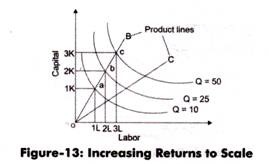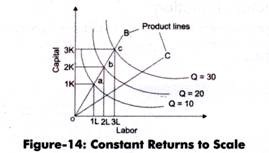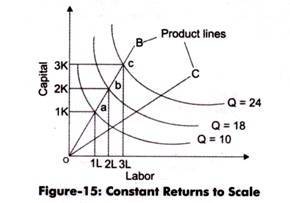The law of returns to scale explains the proportional change in output with respect to proportional change in inputs.
In other words, the law of returns to scale states when there are a proportionate change in the amounts of inputs, the behavior of output also changes.
The degree of change in output varies with change in the amount of inputs. For example, an output may change by a large proportion, same proportion, or small proportion with respect to change in input.
On the basis of these possibilities, law of returns can be classified into three categories:
ADVERTISEMENTS:
i. Increasing returns to scale
ii. Constant returns to scale
iii. Diminishing returns to scale
1. Increasing Returns to Scale:
If the proportional change in the output of an organization is greater than the proportional change in inputs, the production is said to reflect increasing returns to scale. For example, to produce a particular product, if the quantity of inputs is doubled and the increase in output is more than double, it is said to be an increasing returns to scale. When there is an increase in the scale of production, the average cost per unit produced is lower. This is because at this stage an organization enjoys high economies of scale.
ADVERTISEMENTS:
Figure-13 shows the increasing returns to scale:
In Figure-13, a movement from a to b indicates that the amount of input is doubled. Now, the combination of inputs has reached to 2K+2L from 1K+1L. However, the output has Increased from 10 to 25 (150% increase), which is more than double. Similarly, when input changes from 2K-H2L to 3K + 3L, then output changes from 25 to 50(100% increase), which is greater than change in input. This shows increasing returns to scale.
There a number of factors responsible for increasing returns to scale.
ADVERTISEMENTS:
Some of the factors are as follows:
i. Technical and managerial indivisibility:
Implies that there are certain inputs, such as machines and human resource, used for the production process are available in a fixed amount. These inputs cannot be divided to suit different level of production. For example, an organization cannot use the half of the turbine for small scale of production.
Similarly, the organization cannot use half of a manager to achieve small scale of production. Due to this technical and managerial indivisibility, an organization needs to employ the minimum quantity of machines and managers even in case the level of production is much less than their capacity of producing output. Therefore, when there is increase in inputs, there is exponential increase in the level of output.
ii. Specialization:
Implies that high degree of specialization of man and machinery helps in increasing the scale of production. The use of specialized labor and machinery helps in increasing the productivity of labor and capital per unit. This results in increasing returns to scale.
iii. Concept of Dimensions:
Refers to the relation of increasing returns to scale to the concept of dimensions. According to the concept of dimensions, if the length and breadth of a room increases, then its area gets more than doubled.
For example, length of a room increases from 15 to 30 and breadth increases from 10 to 20. This implies that length and breadth of room get doubled. In such a case, the area of room increases from 150 (15*10) to 600 (30*20), which is more than doubled.
2. Constant Returns to Scale:
The production is said to generate constant returns to scale when the proportionate change in input is equal to the proportionate change in output. For example, when inputs are doubled, so output should also be doubled, then it is a case of constant returns to scale.
Figure-14 shows the constant returns to scale:
In Figure-14, when there is a movement from a to b, it indicates that input is doubled. Now, when the combination of inputs has reached to 2K+2L from IK+IL, then the output has increased from 10 to 20.
ADVERTISEMENTS:
Similarly, when input changes from 2Kt2L to 3K + 3L, then output changes from 20 to 30, which is equal to the change in input. This shows constant returns to scale. In constant returns to scale, inputs are divisible and production function is homogeneous.
3. Diminishing Returns to Scale:
Diminishing returns to scale refers to a situation when the proportionate change in output is less than the proportionate change in input. For example, when capital and labor is doubled but the output generated is less than doubled, the returns to scale would be termed as diminishing returns to scale.
Figure-15 shows the diminishing returns to scale:
ADVERTISEMENTS:
In Figure-15, when the combination of labor and capital moves from point a to point b, it indicates that input is doubled. At point a, the combination of input is 1k+1L and at point b, the combination becomes 2K+2L.
However, the output has increased from 10 to 18, which is less than change in the amount of input. Similarly, when input changes from 2K+2L to 3K + 3L, then output changes from 18 to 24, which is less than change in input. This shows the diminishing returns to scale.
Diminishing returns to scale is due to diseconomies of scale, which arises because of the managerial inefficiency. Generally, managerial inefficiency takes place in large-scale organizations. Another cause of diminishing returns to scale is limited natural resources. For example, a coal mining organization can increase the number of mining plants, but cannot increase output due to limited coal reserves.


